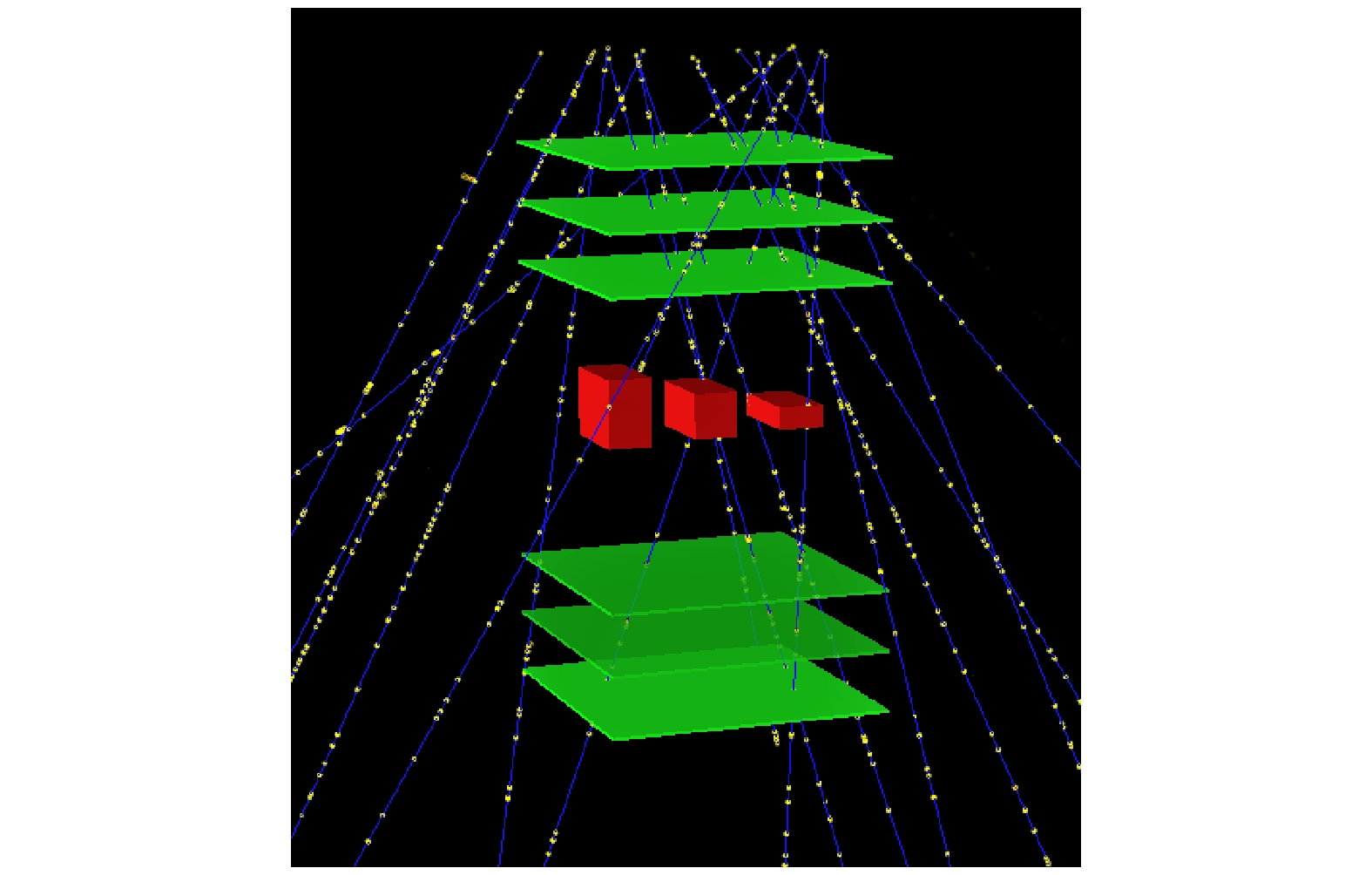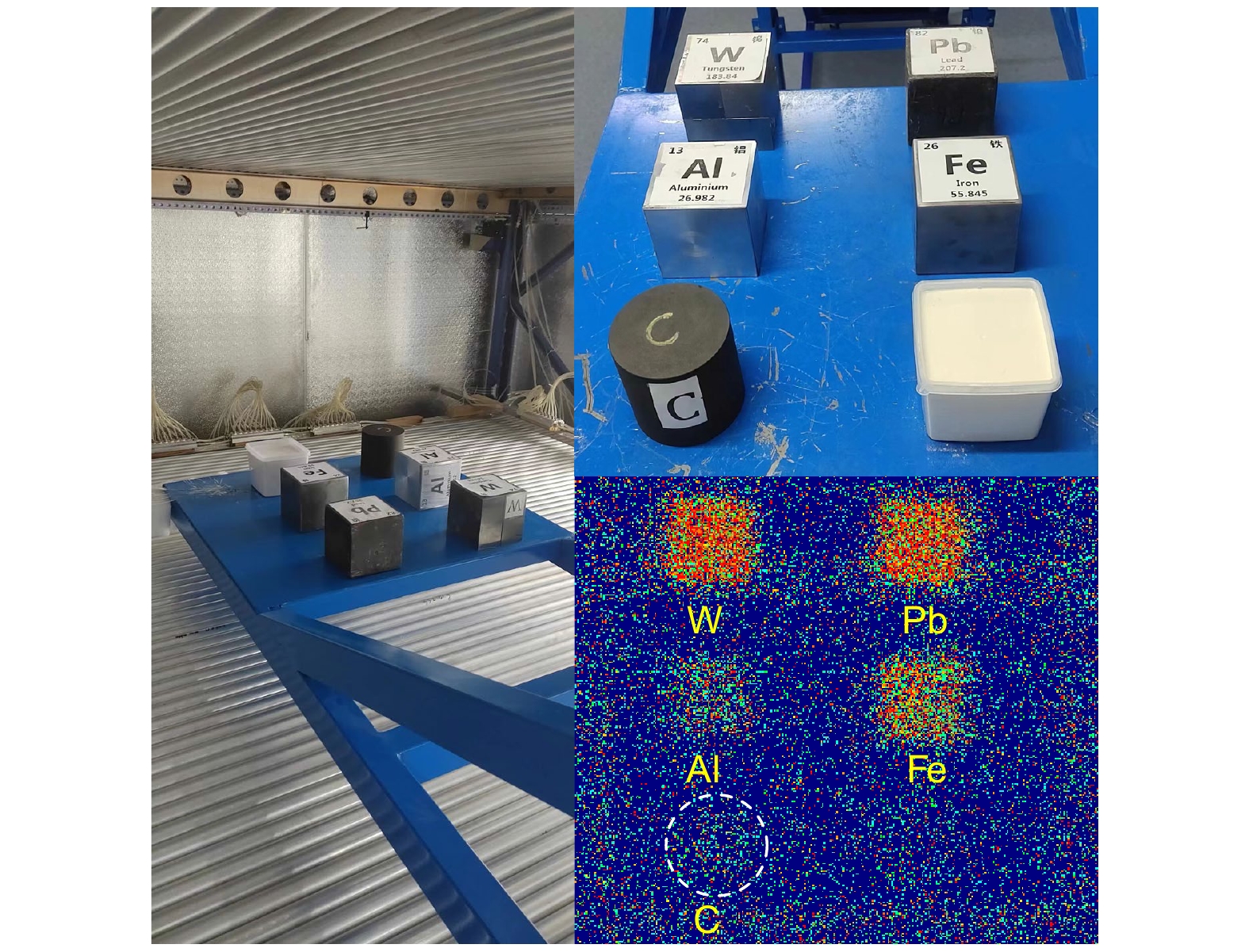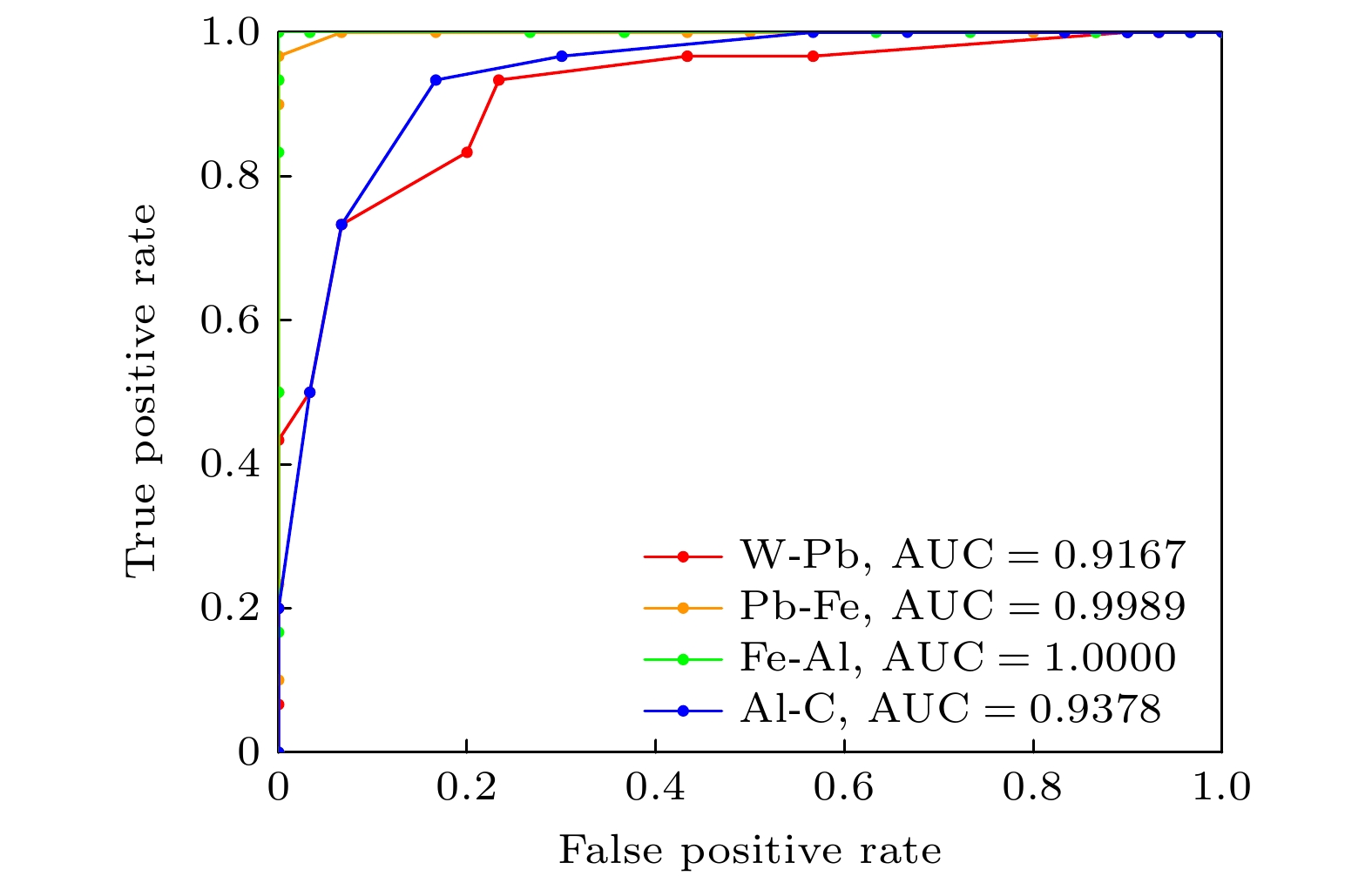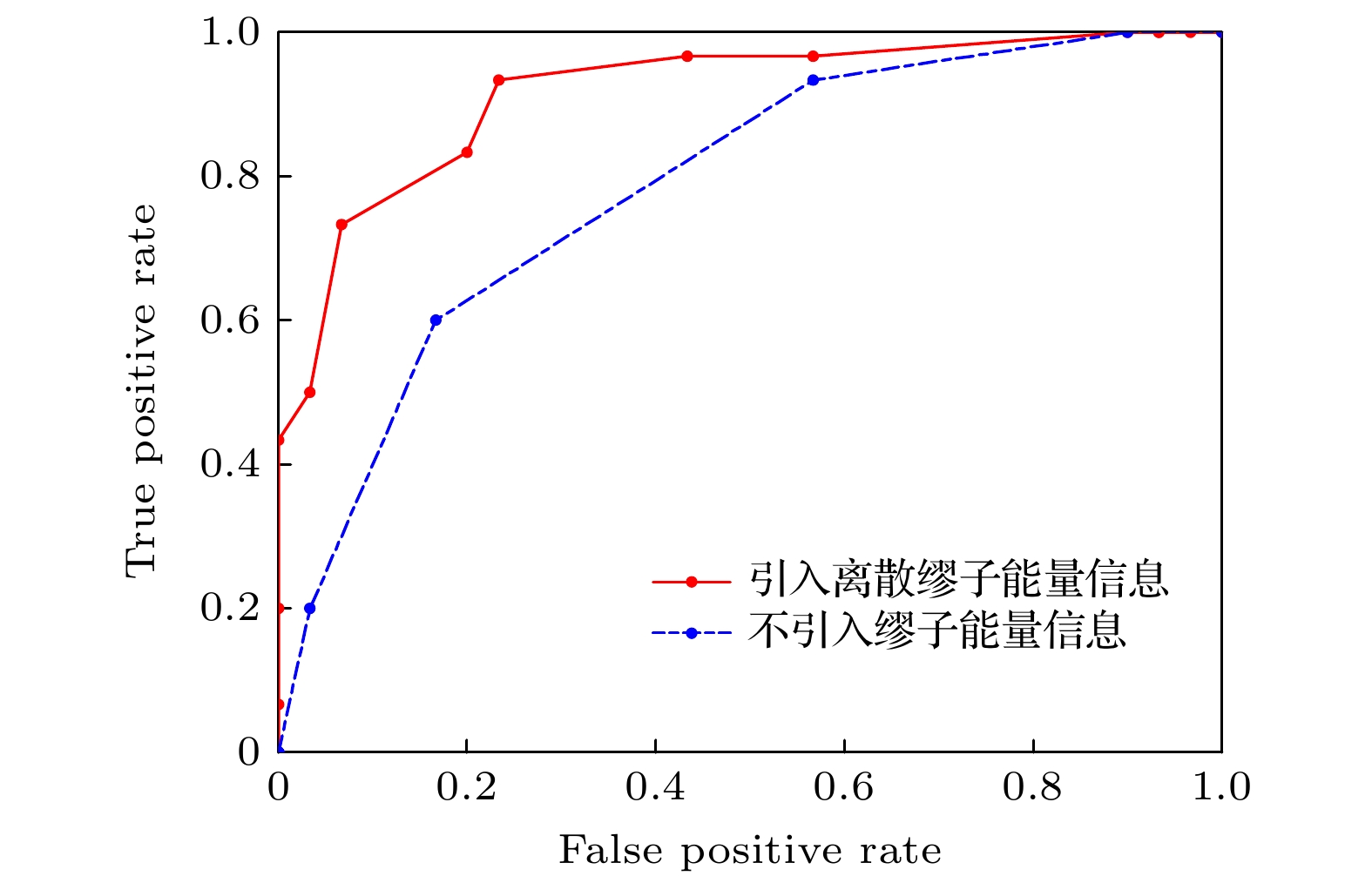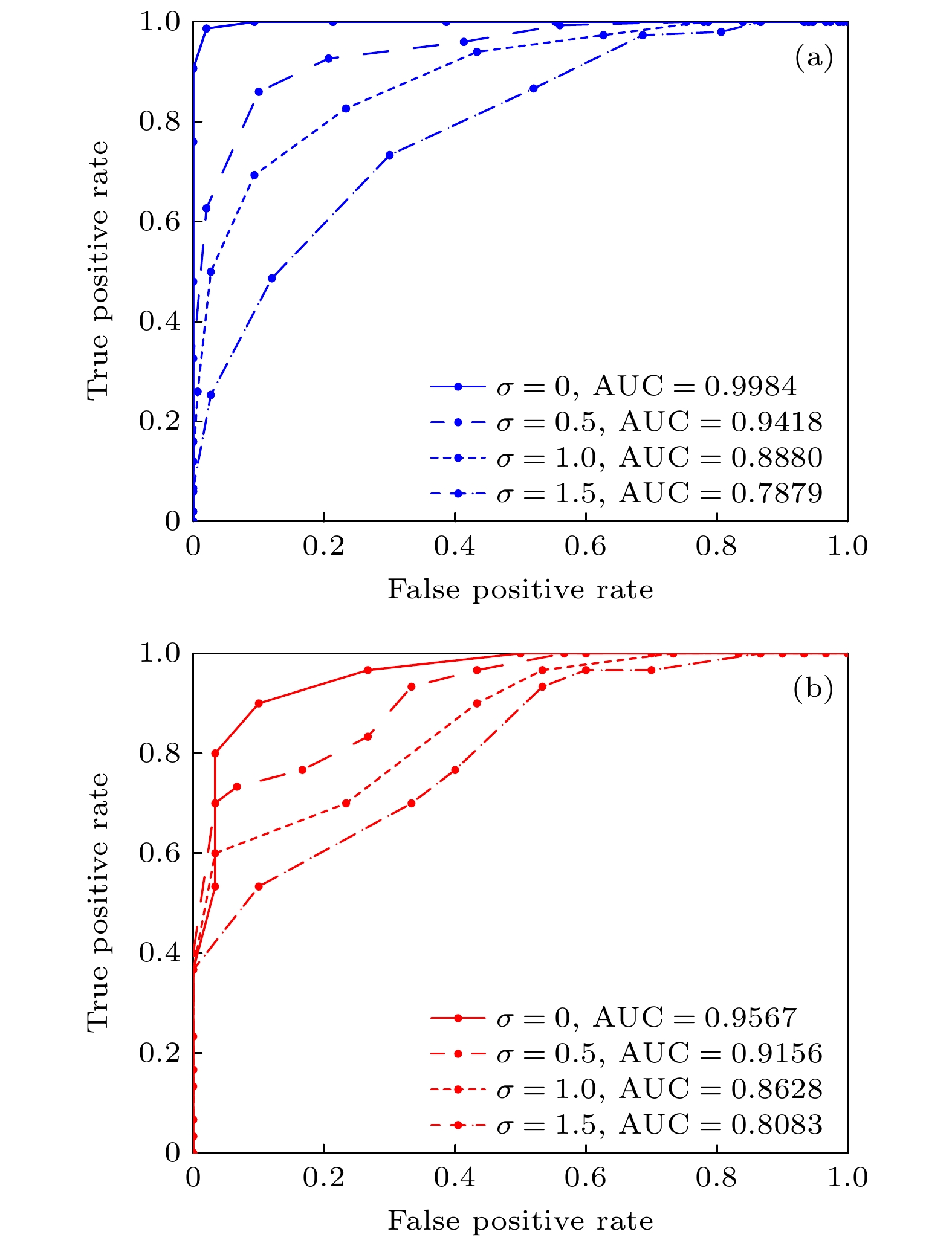-
Cosmic-ray muon is a kind of charged particle with strong penetrating capability and sensitivity to high atomic number materials. In recent years, muongraphy emerged as a novel technique by using cosmic-ray muon to image unknown volume, and is widely applied to nuclear security, geosciences, archaeology and civil engineering. The effect of multiple Coulomb scattering between muons and materials with different atomic number is different, and the scattering angle is related to material Z and muon energy. If we can measure muon scattering angle and muon energy, we can identify the category of material interacted with muon. However, it is difficult to measure the energy of each muon in real time, most of the researches use the mean muon energy ~4 GeV to alternate each muon energy which causes image to blurred and material discrimination accuracy to decrease. This article introduces a method of using the discrete muon energy to fit the scattering angle distribution derived from continuous muon energy and estimate the weight of each discrete muon energy. Then measure the scattering angle of the material to be identified, histogram the scattering angle and couple it with the calibrated scattering angle distribution by discrete muon energy. The last step is to calculate the radiation length from the above equation. The radiation length is a characteristic quantity of the material, and used to identify materials in this method. We carry out the experiment on material’s discrimination based on the apparatus of cosmic-ray muon tomography made by China Institute of Atomic Energy. The system contains 6 layers, consisting of several drift tube detectors planted in two orthogonal coordinate for tracking muon trajectory. Five materials are selected to be distinguished in the experiment, they being C, Al, Fe, Pb, and W. The scattering angles formed by muons passing through these materials are measured respectively, and their radiation lengths are measured and identified in pairs. In order to evaluate material discrimination accuracy, we plot the ROC curve between each pair of materials. The result reveals that Al-Fe and Fe-Pb can be effectively identified at a 95% confidence level, under 1400 valid muon events. Considering that the difference in material density also influences discrimination accuracy, we simulate several other materials identified by Pb. It is concluded that this method can identify the materials with radiation length greater than 0.7 cm. Compared with the discrimination method of unknowing muon energy, this method improves the accuracy of Pb-W discrimination by 18.5%.
-
Keywords:
- cosmic ray muon /
- muon tomography /
- discrete energy /
- material discrimination
[1] Bonechi L, D’Alessandro R, Giammanco A 2020 Rev. Phys. 5 100038
 Google Scholar
Google Scholar
[2] Blanpied G, Kumar S, Dorroh D, et al. 2015 Nucl. Instrum. Methods Phys. Res. Sect. A 784 352
 Google Scholar
Google Scholar
[3] Sossong M, Blanpied G, Kumar S, et al. 2015 Nuclear Threats and Security Challenge (Dordrecht: Springer) pp229–243
[4] Morishima K, Kuno M, Nishio A, et al. 2017 Nature 552 386
 Google Scholar
Google Scholar
[5] Alvarez L W, Anderson J A, Bedwei F E, et al. 1970 Science 167 832
 Google Scholar
Google Scholar
[6] 苏宁, 刘圆圆, 王力, 程建平 2022 物理学报 71 064201
 Google Scholar
Google Scholar
Su N, Liu Y Y, Wang L, Cheng J P 2022 Acta Phys. Sin. 71 064201
 Google Scholar
Google Scholar
[7] Oláh L, Tanaka H K M, Hamar G, et al. 2019 Philos. Trans. R. Soc. A 377 20180135
 Google Scholar
Google Scholar
[8] Tioukov V, Alexandrov A, Bozza C, et al. 2019 Sci. Rep. 9 1
 Google Scholar
Google Scholar
[9] Miyadera H, Borozdin K N, Greene S J, et al. 2013 AIP Adv. 3 052133
 Google Scholar
Google Scholar
[10] Perry J, Azzouz M, Bacon J, et al. 2013 J. Appl. Phys. 113 184909
 Google Scholar
Google Scholar
[11] Poulson D, Durham J M, Guardincerri E, et al. 2017 Nucl. Instrum. Methods Phys. Res. Sect. A 842 48
 Google Scholar
Google Scholar
[12] Borozdin K N, Hogan G E, Morris C, et al. 2003 Nature 422 277
 Google Scholar
Google Scholar
[13] Priedhorsky W C, Borozdin K N, Hogan G E, et al. 2003 Rev. Sci. Instrum. 74 4294
 Google Scholar
Google Scholar
[14] Schultz L J, Borozdin K N, Gomez J J, et al. 2004 Nucl. Instrum. Methods Phys. Res. Sect. A 519 687
 Google Scholar
Google Scholar
[15] Vanini S, Calvini P, Checchia P, et al. 2019 Philos. Trans. R. Soc. A 377 20180051
 Google Scholar
Google Scholar
[16] Bae J, Chatzidakis S 2021 arXiv: 2109.02470 [physics. ins-det]
[17] Morris C L, Bacon J, Borozdin K, et al. 2013 AIP Adv. 3 082128
 Google Scholar
Google Scholar
[18] Anghel V, Armitage J, Baig F, et al. 2015 Nucl. Instrum. Methods Phys. Res. Sect. A 798 12
 Google Scholar
Google Scholar
[19] Luo Z F 2016 Ph. D. Dissertation (Beijing: Tsinghua University) (in Chinese)
[20] Particle Data Group, Workman R L, Burkert V D, et al. 2022 Prog. Theor. Exp. Phys. 2022 083C01
 Google Scholar
Google Scholar
[21] Bethe H A 1953 Phys. Rev. 89 1256
 Google Scholar
Google Scholar
[22] Lynch G R, Dahl O I 1991 Nucl. Instrum. Methods Phys. Res. Sect. B 58 6
 Google Scholar
Google Scholar
[23] Agostinelli S, Allison J, Amako K, et al. 2003 Nucl. Instrum. Methods Phys. Res. Sect. A 506 250
 Google Scholar
Google Scholar
[24] Hagmann C, Lange D, Verbeke J, et al. 2012 Lawrence Livermore National Laboratory Document UCRL-TM-229453
[25] Particle Data Group http://pdg. lbl. gov/2011/AtomicNuclearProperties [2022-8-15]
-
表 1 离散能量权重模拟结果与实验结果
Table 1. Discrete energy’s weights of experiment and simulation.
A1 A2 A3 A4 A5 A6 A7 A8 A9 实验结果 –0.029 0.089 0.081 0.140 0.084 0.033 –0.005 0.000 0.001 模拟结果 0.022 0.038 0.095 0.100 0.084 0.043 0.021 0.005 0.003 表 2 不同材料辐射长度的估计值与相对误差
Table 2. Estimated radiation lengths of different materials with relative error.
实验结果/cm
(相对误差/%)模拟结果/cm
(相对误差/%)标准值/cm C 1.985 (89.7) 17.050 (11.7) 19.320 Al 1.572 (82.3) 8.550 (3.9) 8.897 Fe 1.049 (40.3) 1.875 (6.7) 1.757 Pb 0.5878 (4.7) 0.5629 (0.3) 0.5612 W 0.3845 (9.7) 0.3583 (2.2) 0.3504 表 3 各材料鉴别准确率
Table 3. Distinguishment accuracy of the different materials.
鉴别材料 C-Al Al-Fe Fe-Pb Pb-W 准确率/% 88.3 100 98.3 85.0 表 4 材料鉴别准确率与辐射长度的关系
Table 4. Materials distinguishment accuracy versus the radiation length.
材料种类 辐射长度标准值/cm 与Pb材料鉴别准确率/% Pb 0.5612 — Ag 0.8543 81.7 Cd 1.040 91.7 Sn 1.206 95.0 Cu 1.568 100.0 Fe 1.757 100.0 -
[1] Bonechi L, D’Alessandro R, Giammanco A 2020 Rev. Phys. 5 100038
 Google Scholar
Google Scholar
[2] Blanpied G, Kumar S, Dorroh D, et al. 2015 Nucl. Instrum. Methods Phys. Res. Sect. A 784 352
 Google Scholar
Google Scholar
[3] Sossong M, Blanpied G, Kumar S, et al. 2015 Nuclear Threats and Security Challenge (Dordrecht: Springer) pp229–243
[4] Morishima K, Kuno M, Nishio A, et al. 2017 Nature 552 386
 Google Scholar
Google Scholar
[5] Alvarez L W, Anderson J A, Bedwei F E, et al. 1970 Science 167 832
 Google Scholar
Google Scholar
[6] 苏宁, 刘圆圆, 王力, 程建平 2022 物理学报 71 064201
 Google Scholar
Google Scholar
Su N, Liu Y Y, Wang L, Cheng J P 2022 Acta Phys. Sin. 71 064201
 Google Scholar
Google Scholar
[7] Oláh L, Tanaka H K M, Hamar G, et al. 2019 Philos. Trans. R. Soc. A 377 20180135
 Google Scholar
Google Scholar
[8] Tioukov V, Alexandrov A, Bozza C, et al. 2019 Sci. Rep. 9 1
 Google Scholar
Google Scholar
[9] Miyadera H, Borozdin K N, Greene S J, et al. 2013 AIP Adv. 3 052133
 Google Scholar
Google Scholar
[10] Perry J, Azzouz M, Bacon J, et al. 2013 J. Appl. Phys. 113 184909
 Google Scholar
Google Scholar
[11] Poulson D, Durham J M, Guardincerri E, et al. 2017 Nucl. Instrum. Methods Phys. Res. Sect. A 842 48
 Google Scholar
Google Scholar
[12] Borozdin K N, Hogan G E, Morris C, et al. 2003 Nature 422 277
 Google Scholar
Google Scholar
[13] Priedhorsky W C, Borozdin K N, Hogan G E, et al. 2003 Rev. Sci. Instrum. 74 4294
 Google Scholar
Google Scholar
[14] Schultz L J, Borozdin K N, Gomez J J, et al. 2004 Nucl. Instrum. Methods Phys. Res. Sect. A 519 687
 Google Scholar
Google Scholar
[15] Vanini S, Calvini P, Checchia P, et al. 2019 Philos. Trans. R. Soc. A 377 20180051
 Google Scholar
Google Scholar
[16] Bae J, Chatzidakis S 2021 arXiv: 2109.02470 [physics. ins-det]
[17] Morris C L, Bacon J, Borozdin K, et al. 2013 AIP Adv. 3 082128
 Google Scholar
Google Scholar
[18] Anghel V, Armitage J, Baig F, et al. 2015 Nucl. Instrum. Methods Phys. Res. Sect. A 798 12
 Google Scholar
Google Scholar
[19] Luo Z F 2016 Ph. D. Dissertation (Beijing: Tsinghua University) (in Chinese)
[20] Particle Data Group, Workman R L, Burkert V D, et al. 2022 Prog. Theor. Exp. Phys. 2022 083C01
 Google Scholar
Google Scholar
[21] Bethe H A 1953 Phys. Rev. 89 1256
 Google Scholar
Google Scholar
[22] Lynch G R, Dahl O I 1991 Nucl. Instrum. Methods Phys. Res. Sect. B 58 6
 Google Scholar
Google Scholar
[23] Agostinelli S, Allison J, Amako K, et al. 2003 Nucl. Instrum. Methods Phys. Res. Sect. A 506 250
 Google Scholar
Google Scholar
[24] Hagmann C, Lange D, Verbeke J, et al. 2012 Lawrence Livermore National Laboratory Document UCRL-TM-229453
[25] Particle Data Group http://pdg. lbl. gov/2011/AtomicNuclearProperties [2022-8-15]
Catalog
Metrics
- Abstract views: 7231
- PDF Downloads: 88
- Cited By: 0















 DownLoad:
DownLoad:
